We have compiled a list of the best website builders on the internet for you. You will learn how they work, what features they offer, and their advantages and disadvantages. With these builders, you can solve various tasks and create a website for free.
A website builder is a service that allows you to create a site on your own using ready-made blocks and templates. Website builders are designed to free users from traditional development and make building a web resource fast and accessible. Using the service does not require any programming skills — just assemble the site from a set of elements following the instructions.
In this article, you will learn the essentials about website builders and how they work, along with their advantages and disadvantages. We have gathered the best website builders and categorized them by their suitability for creating landing pages, corporate websites, and online stores. To help you compare builders across the most important aspects, we have also included tables.
What is a website builder
To use an online website builder, you don’t need to install any third-party software on your computer or server. The builder is managed directly through the developer’s website in your browser. After registering, the user enters a workspace where they can create and manage their site.
The interface of most website builders resembles that of graphic editors. The user is given a blank canvas and a set of tools to fill it — for example, the ability to create new pages, buttons, forms, and more. To simplify the process, builders also provide sets of pre-designed blocks and templates. Let’s take a step-by-step look at how a website builder works.
-
Users can choose from dozens of templates categorized by theme and purpose — for instance, a personal portfolio, a corporate site for a transportation company, or an online store for dietary supplements. The type of site determines which templates are offered and how many pages the site will include.
-
After selecting a template, the user can begin editing it. Blocks can be deleted, moved, or customized in appearance. If desired, the template can be left “as is” with only the standard content replaced by personal information.
-
If a user wants to add a new block, they simply choose one from the list of available options and drag it onto the page. Most builders use a “drag and drop” model, meaning users don’t need to create elements from scratch. Instead, they adapt a ready-made block to their needs — for example, by changing its size, color, and other details.
-
For a site to become accessible to others, it must be published. This requires selecting a domain name — the address where people can find the site — and connecting hosting, the server that stores the website and its data. In many cases, hosting and domain services are included in the builder package, making this step simple.
-
Website builders are typically paid services, so along with hosting and domain setup, users must choose and pay for a subscription plan to activate their site. This fee is charged monthly. Some services offer a free plan, but its features are usually limited. For a fully functional website, especially one more complex than a landing page, a paid subscription is usually necessary.
Most website builders operate according to this principle. Mastering them is not difficult, even if you have never created a site before or lack design skills. A website builder is essentially a graphic editor. Its operation can be compared to building with Lego blocks: you assemble the pieces following instructions or arrange them in any form, but you are still limited to the blocks provided and to certain rules of assembly.
From this description, one might think that a website builder is only suitable for very basic projects. Indeed, the tool is intentionally simple to make site creation accessible. At the same time, it is entirely possible to launch fairly complex websites, including online stores. The outcome depends on the builder’s technical capabilities and the user’s level of experience. The more you learn about website builders, the better you will understand their hidden features and make full use of the available tools. This allows you to create not just a generic template, but an engaging and distinctive project.
Advantages and disadvantages of website builders
Advantages of website builders:
-
wide selection of services — today the market offers many builders with strong feature sets and varied pricing models, allowing everyone to find a suitable option;
-
ease of use — anyone can create a website with a builder, and if you have never done it before, this is an excellent way to launch your first site;
-
fast website launch — skipping traditional development significantly reduces the time needed to build a site. From choosing a template to going live can take just a few hours, depending on how much customization you apply;
-
no additional fixes or major technical issues — all site elements and templates are developed centrally to ensure compatibility, so users do not need to modify them for proper functionality;
-
responsive design — templates are typically created for both mobile and desktop versions. Any changes made to one version are automatically applied to the other, ensuring correct display;
-
template variety — the idea that all builder-based websites look the same due to templates is outdated. Services now offer hundreds of different templates that can be customized and adapted to fit a specific business.
Disadvantages of website builders:
-
limited customization — users are restricted to the features provided by the builder and rarely have access to the code to make their own modifications;
-
not always suitable for every task — there is an opinion that builders are not ideal for creating complex websites, although much depends on the service’s specialization;
-
possible lack of localization — not all website builders support multilingual functionality. Typically, only a few popular interface languages are available, while less common ones, such as Romanian or Estonian, may be missing, leaving users from different countries to work with the English version;
-
potential scalability issues — if a very basic builder is chosen, its functionality may prove insufficient for future business growth and site development;
-
complicated migration to other platforms — not all builders allow easy export of site data, which can make transferring a website to another platform difficult.
Website builders for creating landing pages
In this section, we’ve gathered services that are best suited for building simple websites such as landing pages, business card sites, and similar projects. While these builders can also be used to create more complex resources, the results tend to be overly simplified, making them better suited for single-page sites. Here is the top selection of website builders for creating landing pages:
-
Canva;
-
Google Sites;
-
GoDaddy;
-
Squarespace.
Canva
Canva is a well-known online graphic editor used for creating banners, email templates, and other design elements. Among its many features, the platform also allows users to build websites. Canva’s workspace is simple, making it easy to navigate its tools. Website templates are divided by type of resource, but they can also be combined. For example, you can take several pages from one template, add one from another, and a few more from a third. In addition to ready-made templates, Canva offers page layouts — essentially ideas of how a page might look. Although Canva websites can technically consist of multiple pages, they are all merged into one long main page. For this reason, and because the service emphasizes visual design, Canva is best suited for landing pages.
Since Canva is designed for a wide range of graphic projects, it does not offer traditional website pricing plans. Instead, the service provides a Pro subscription that unlocks additional design editing features as well as access to paid templates. The subscription costs $15 per month. With it, users gain enhanced editing tools for websites and expanded functionality for the graphic editor. However, publishing a website is possible without a subscription, though in this case the site address will include Canva’s branding.
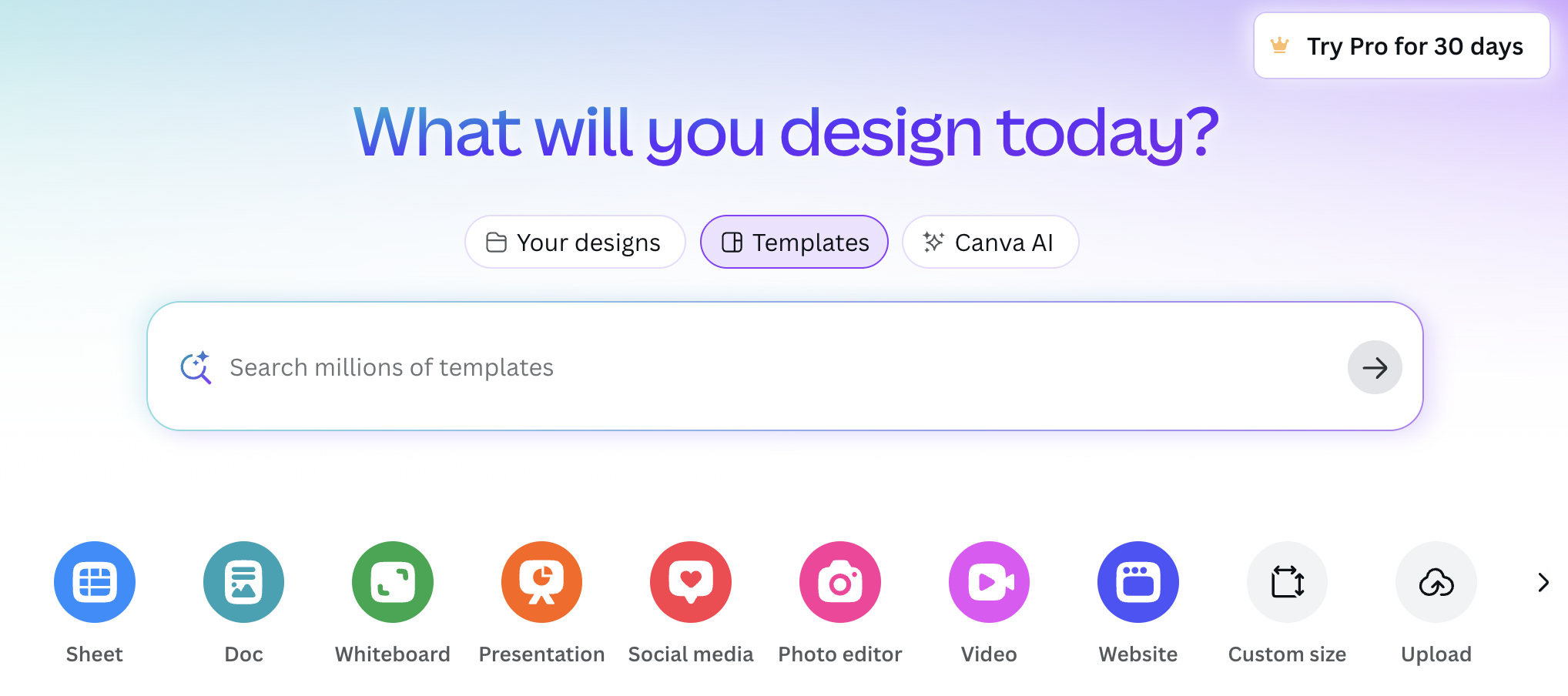
Google Sites
Google Sites is a website builder from Google. To use the service, you only need a Google account. The company offers a small selection of templates that allow for minor customization. The workspace and website creation process resemble building a presentation. All tools are intuitive, so users should not encounter difficulties. Given its simplicity, Google Sites is best suited for creating lightweight business card websites or similar projects. An added bonus for more advanced users is the option to insert HTML code into the site.
Google Sites does not have paid plans, although premium templates can be purchased separately. To make the domain look professional, it must be bought separately and connected to the site, with ownership of the address confirmed.
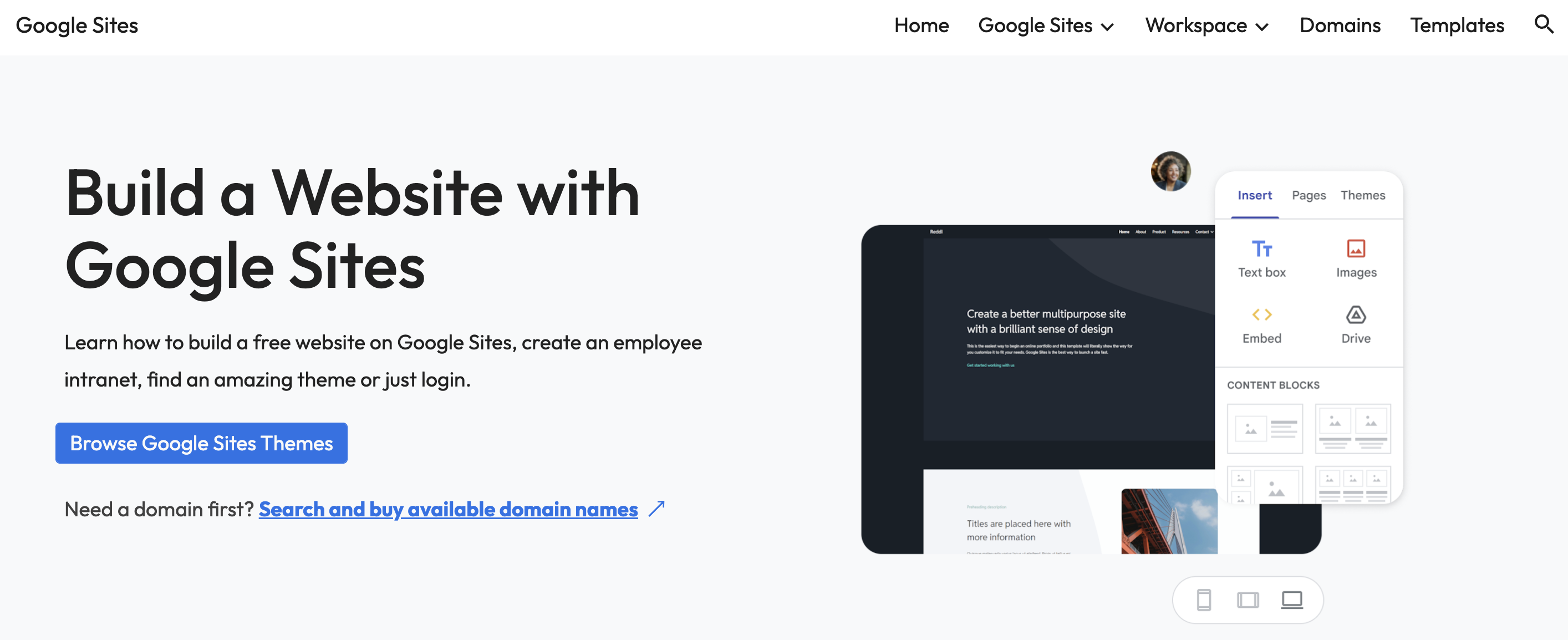
GoDaddy
GoDaddy is an American company that provides hosting and domain registration services. Among its offerings is its own website builder. Users can quickly create a site in just a few steps. GoDaddy automatically selects a design option based on the user’s answers about the site’s purpose and focus. However, users can also choose a template manually. The builder does not allow for significant changes to templates, so customization options are limited.
Despite these design restrictions, the builder places emphasis on other features, particularly SEO, analytics, and advertising. Search engine optimization on the platform is largely automated, with GoDaddy essentially handling much of the work for users. For example, the service can automatically select keywords for optimization. To make it easier to launch a site, the builder suggests which steps should be taken, analyzing what the user has already done and what is still missing. Publishing a site is free, but to gain access to advanced design options, an SSL certificate, a domain, and other features, a paid plan is required. Pricing for the builder starts at $11 per month.
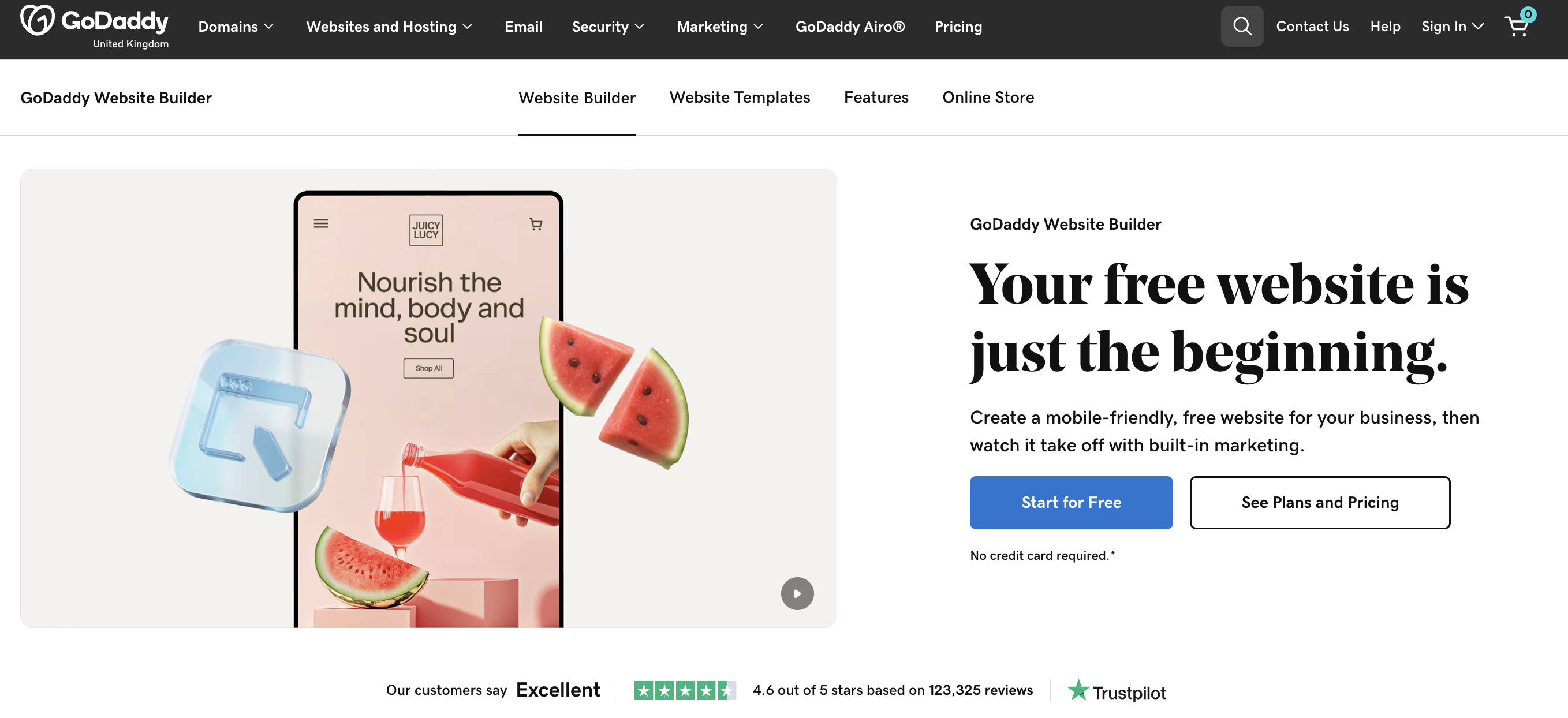
Squarespace
Squarespace offers users two options for creating a website:
-
manually, using one of the ready-made templates;
-
with the help of artificial intelligence, which builds a site based on your preferences.
The second option is more engaging and aims to make the site more personalized. First, you complete a short questionnaire about your business field, the site’s purpose, and which blocks and pages you need. However, this does not mean the service does everything for you — user involvement is still required, such as editing the final result.
If desired, Squarespace can not only generate a design using AI but also create text content. To do this, the service asks for a brief description of the site and then transforms the information into content according to the chosen writing style. The generated text can also be edited manually. Squarespace does not offer a free plan, so to publish a website you must pay a subscription fee. Pricing starts at $25 per month.

| Name of the builder |
Canva |
Google Sites |
GoDaddy |
Squarespace |
|
Number of templates |
1000+ | 65+ | 20 | 180+ |
|
Availability of a free plan |
Yes |
Yes |
No |
No |
|
Monthly cost |
$15 | Free | From $11 | From $25 |
|
Complexity of use |
Easy |
Easy |
Medium |
Easy |
Website builders for сreating сorporate websites
Corporate websites are business-owned sites that inform users about the company. Unlike simple landing pages, a corporate site not only introduces people to the business but can also directly offer specific services. For this reason, a basic one-page site is not enough — what’s needed is a more advanced solution. Accordingly, the builder must provide broader functionality for website creation. Our top selection of website builders for creating corporate websites includes:
-
Webflow;
-
Site123;
-
Jimdo;
-
Site.Pro;
-
IM Creator.
Webflow
Webflow is a specialized platform for creating modern websites. After choosing a free or paid design, the builder guides users step by step through the site creation process — for example, changing colors and fonts, replacing default images, enhancing site blocks, and more. In addition to standard settings, the platform offers a wide range of advanced tools that allow users to tailor a site to their specific needs. To help users get acquainted with the builder, Webflow provides a variety of video tutorials.
The complexity of the platform is also reflected in its option to hire a certified Webflow partner to help build a website. The builder also features a marketplace of third-party applications that can be integrated into the site, with both free and paid options available. Webflow offers a free plan that allows for a two-page website with a Webflow domain. Paid plans start at $18 per month.
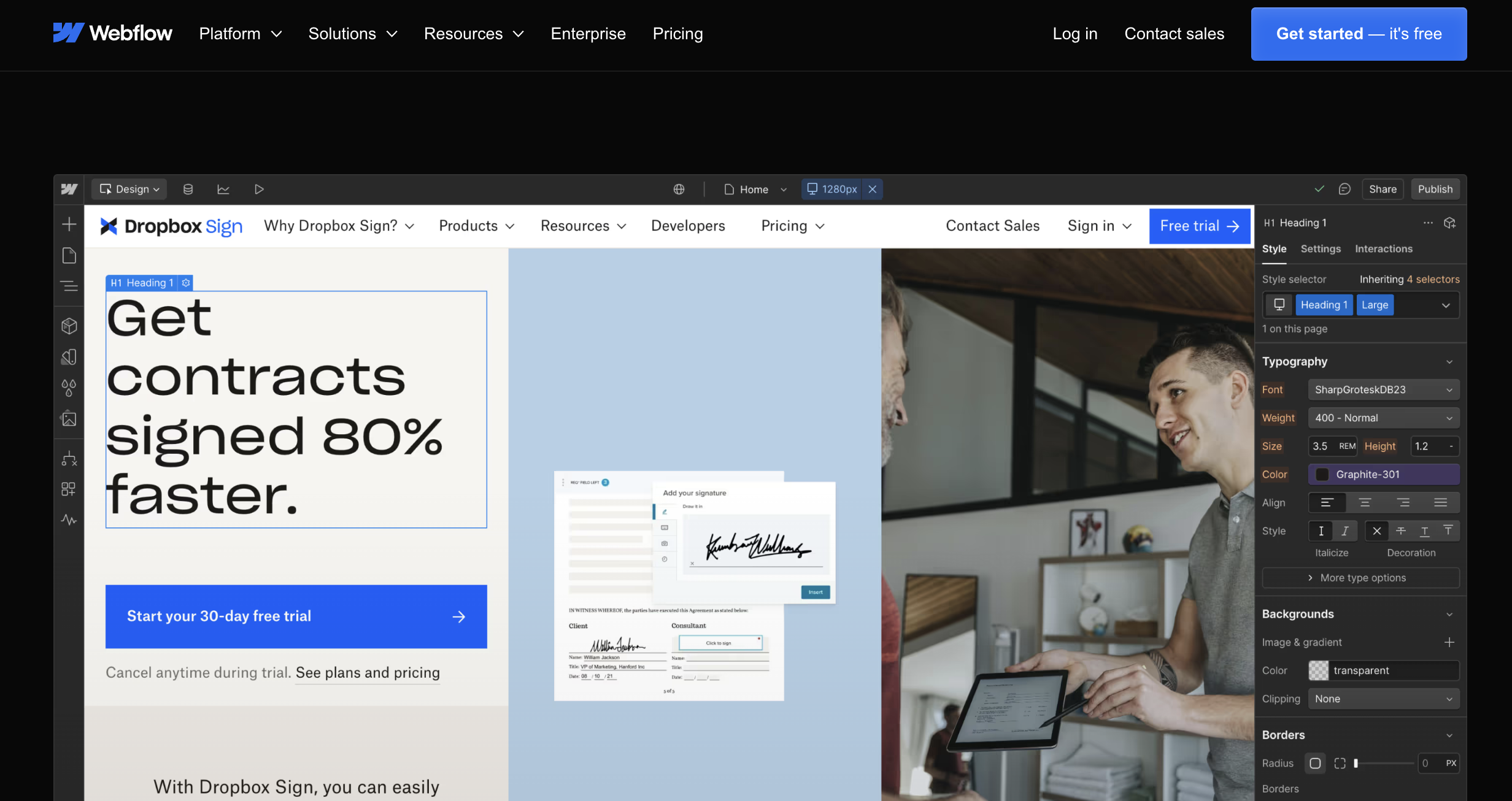
Site123
Site123 enables users to quickly create a website with minimal setup. The builder automatically selects a design template based on the information provided, though users can still make changes during the editing stage. All settings are intuitive, but some features are unavailable on the free plan. For example, enabling cookie consent or adding site search is restricted to paid plans. Many site elements are added with simple toggles, meaning users don’t even need to use drag-and-drop functionality. Paid plans start at $8 per month. If billed annually, the company also provides a free domain for 12 months.
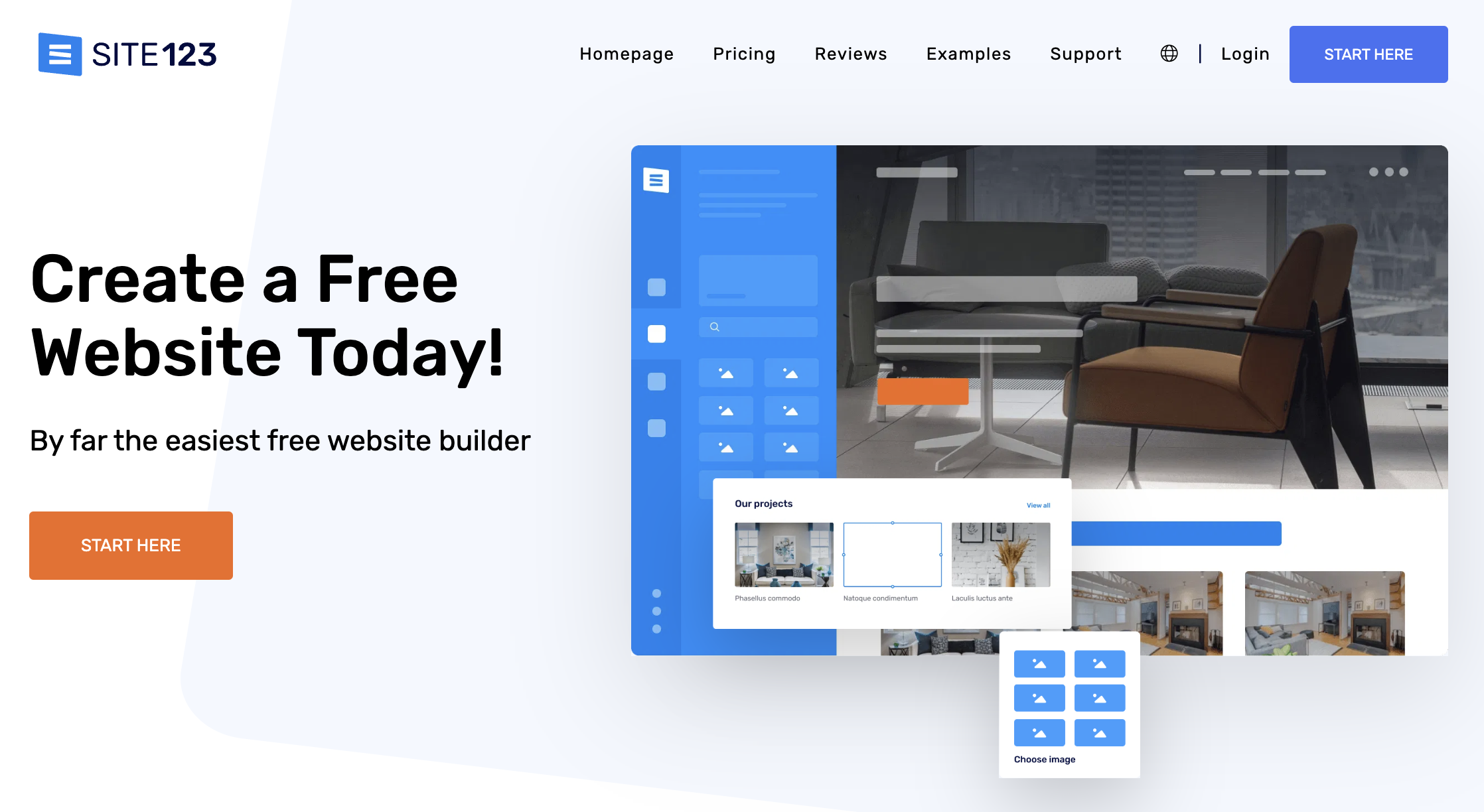
Jimdo
Jimdo is a German website builder that offers two approaches to site creation, depending on the user’s programming experience. For the simpler option, the service provides a questionnaire to help select suitable templates and settings. The survey is standard but important, asking who the site is for, what goals it should achieve, and what style it should follow. As a result, users receive a modern and appealing design with the option to make adjustments. Customization options are generally limited to minor changes such as fonts, block shapes, or color schemes.
Jimdo offers a free plan that, compared to many competitors, has relatively few restrictions. The main limitations are the use of a company subdomain in the address and the presence of ads. These restrictions can be removed with the basic paid plan, which starts at $11 per month.

Site.Pro
Site.Pro is a website builder that, according to its creators, provides around 200 templates. The company sells its solution not only directly but also through partners. These partners purchase the builder under a white-label model, allowing third parties to distribute the product under their own brand. As a result, the Site.Pro builder is often encountered as a feature offered by hosting providers.
The platform itself offers extensive functionality. Users can choose a template and begin editing it immediately without delays. The workspace cannot be considered simple, so it takes time to learn all the available features. However, this is due to the wide range of capabilities provided. In addition to design editing, users can add widgets, extra buttons, elements, media files, and perform certain SEO adjustments, among other tasks. The platform has a free version, though it includes advertising. Paid plans start at $1.50 per month.
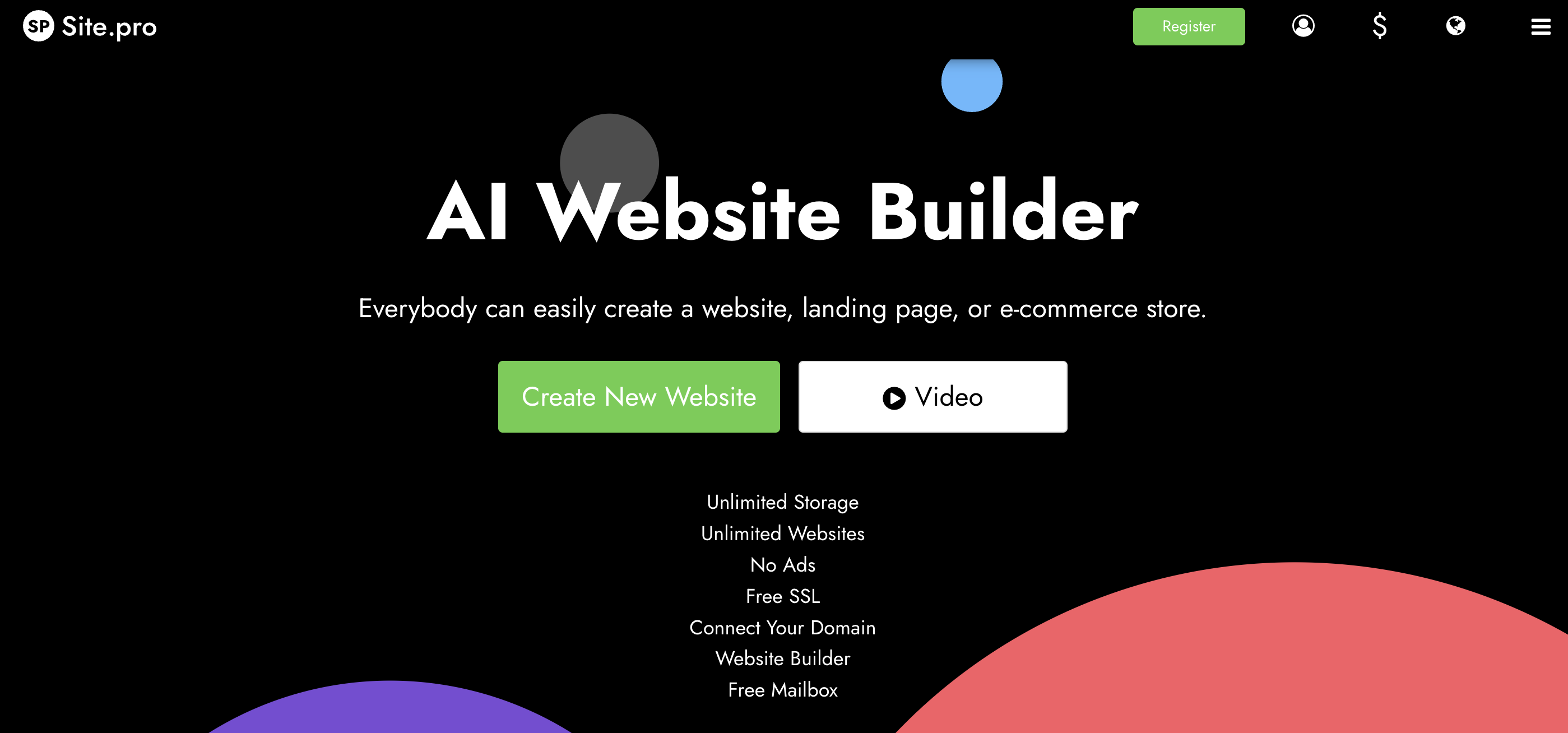
IM Creator
IM Creator is another company that provides hosting services while also offering a website builder. The builder’s interface is very minimalistic, which at first glance may make the platform seem limited. However, upon closer exploration, it reveals a variety of useful features and tools for template customization. Getting familiar with them may not be straightforward, and in some cases, users may need to test settings in practice to fully understand how they work. The platform offers instructions, a forum, and direct communication with support through a contact form or email. Paid plans include extended customer support.
IM Creator allows users to insert custom HTML code, set search engine optimization parameters, add widgets, and work extensively with both the website as a whole and its individual pages. To publish a website, users must purchase a domain. A limited free plan is available, though it includes advertising. Paid plans start at $8 per month. Recently, IM Creator launched a major update and introduced IM COSMOS — a project that integrates AI tools and expanded features for users. It is currently available in beta version.
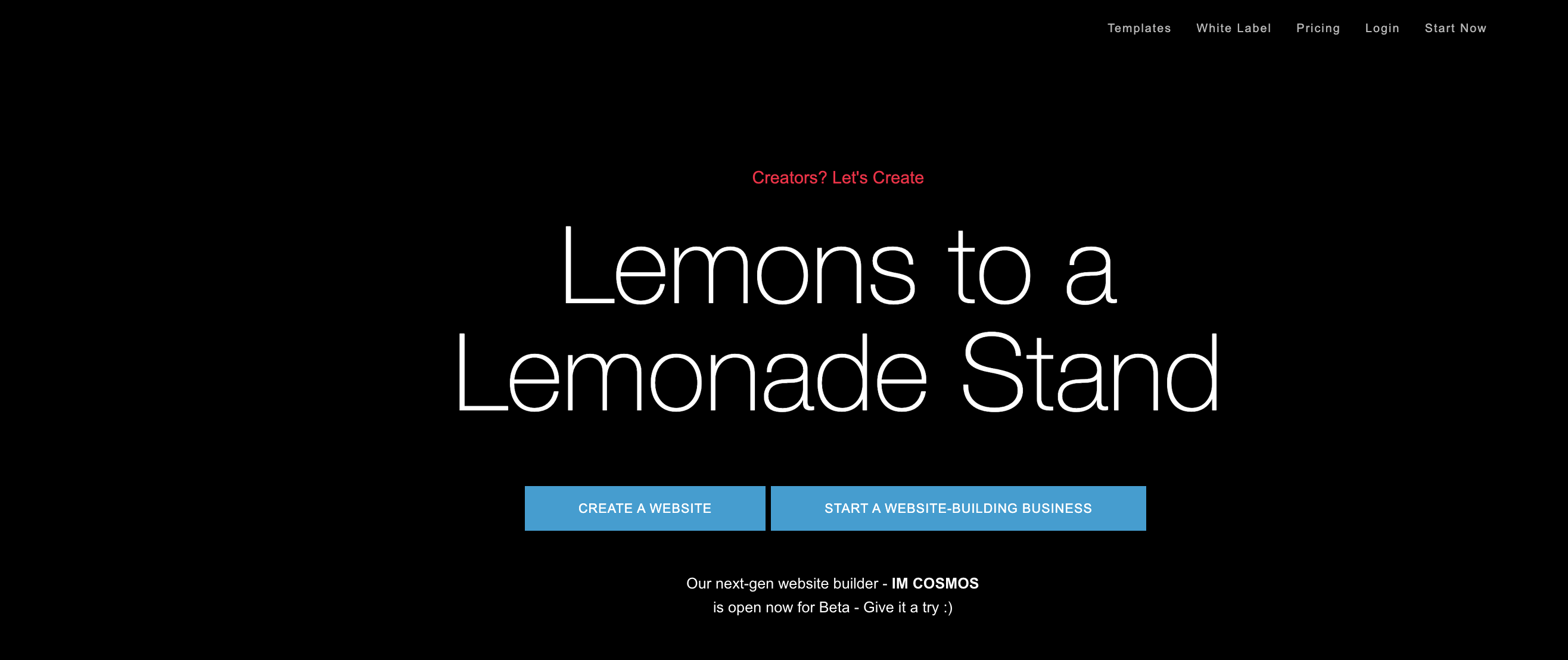
| Name of the builder |
Webflow |
Site123 |
Jimdo |
Site.Pro |
IM Creator |
|
Number of templates |
2000+ | About 100 | 100+ | 200+ | 100+ |
|
Availability of a free plan |
Yes | Yes | Yes | Yes |
Yes |
|
Monthly cost |
From $18 | From $8 | From $11 | From $1,5 | From $8 |
|
Complexity of use |
Difficult |
Easy |
Easy |
Difficult |
Medium |
Website builders for creating online stores
An online store is the most complex type of website. It requires more than just good design and ease of use. An e-commerce site must include a wide range of features and integrations to serve customers effectively. Most importantly, it contains many pages that need to function seamlessly together. For this reason, website builders designed for creating online stores must offer advanced technical capabilities. Top website builders for creating online stores:
-
Cartum;
-
Wix;
-
Shopify;
-
Elementor.
Cartum
Cartum is an international cloud-based platform for creating online stores. Building a site on the platform requires no programming or design skills. Users can choose from over 200 free ready-made templates and use a convenient design editor to customize the selected template and adjust the site’s appearance.
An online store built on the platform supports retail sales of physical and digital products, dropshipping, and wholesale trade, with dedicated features for each type of business. In addition, client websites on the platform include a mobile version, multilingual and multi-currency support, as well as integrations with analytics and marketing services, popular payment systems, and delivery providers.
Cartum is the best option for those who want to fully focus on running their business without worrying about the technical aspects of managing an online store. The platform’s specialists provide support through online chat, handle updates, and protect websites from potential cyberattacks. All of this is included in the subscription fee with no extra charges. The minimum Cartum plan costs €9 per month. A 7-day free trial is also available for clients to explore the platform’s features.
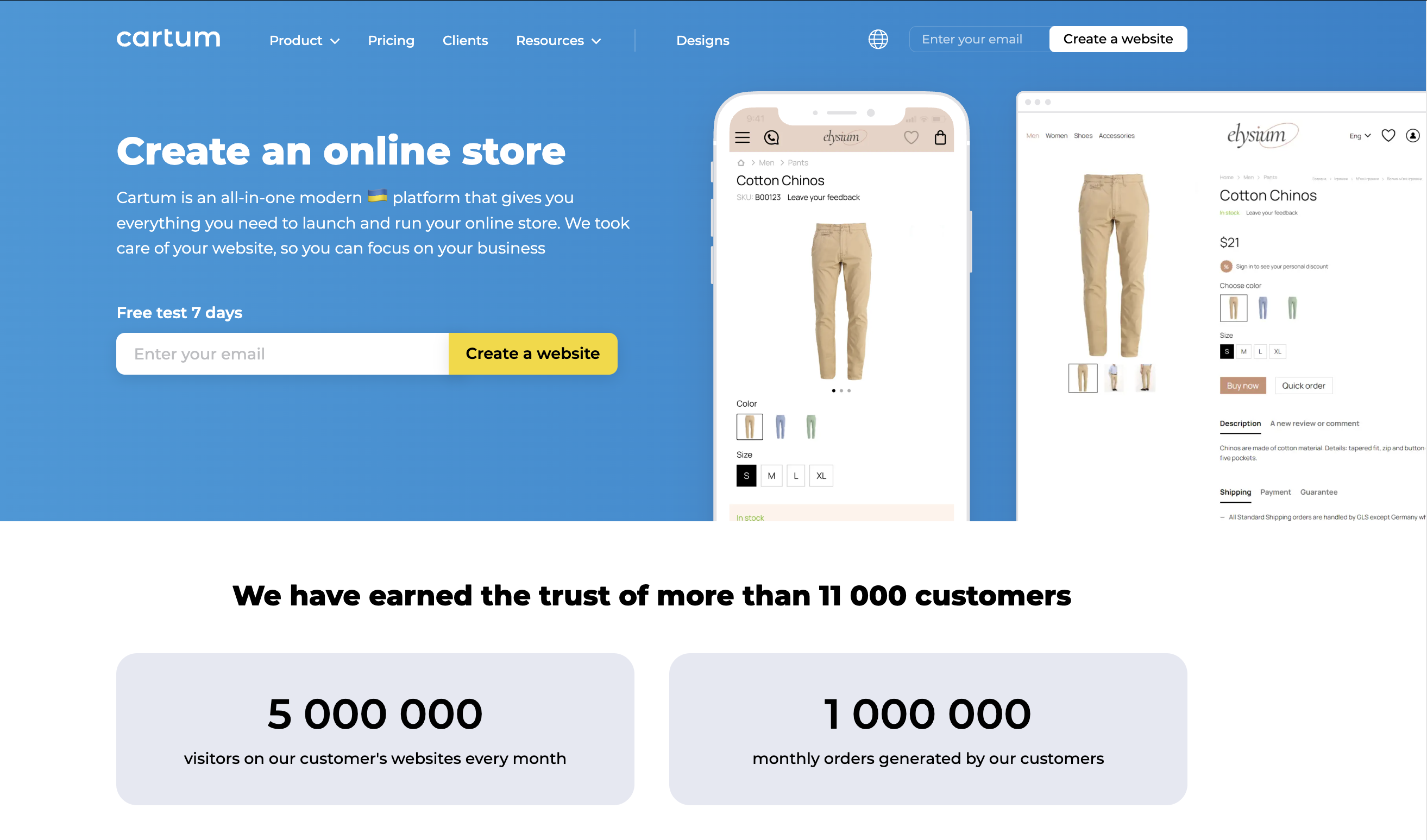
Wix
Wix is one of the most popular online website builders in the world, with over 200 million websites created using the platform. It follows the classic website builder model, where users build their sites in a visual editor. Wix offers more than 900 templates, but only about 120 are specifically designed for online stores. If desired, users can generate a template with the help of artificial intelligence or edit one of the ready-made options manually, with plenty of tools available for customization.
To enhance the user experience, Wix provides its own logo maker, SEO tool, app store, and a marketplace of services from professionals familiar with the platform’s capabilities. The cheapest plan for creating an e-commerce site starts at $29 per month. Wix also offers a 14-day free trial.

Shopify
Shopify is one of the most well-known e-commerce website builders worldwide. Creating a site with Shopify begins somewhat differently compared to other platforms. Users are prompted to first add products to the site and connect a domain, and only afterward move on to design customization. However, these steps can be rearranged and completed in any order. Shopify users can choose from over 900 templates. Only 24 of them are free, and they are fairly simple and universal. All other templates must be purchased separately, with prices ranging from $100 to $500. To simplify selection, templates can be filtered by business niche.
Shopify offers a three-day free trial to get acquainted with the platform. Beyond standard settings, its capabilities can be extended through free and paid apps and integrations, most of which are developed by third parties. Their pricing is set by the developers themselves. Expenses for an online store do not stop at templates, apps, and integrations — users also pay a monthly subscription fee, with the entry-level plan starting at €27 per month. Additionally, Shopify charges transaction fees from online stores for orders paid through external payment systems such as PayPal, Stripe, LiqPay, and others. No extra fees apply when using Shopify Payments, the platform’s own payment gateway. The commission percentage depends on the chosen plan, for the entry-level plan, it is 2%.

Elementor
Elementor is a specialized WordPress plugin that transforms the CMS into a website builder. With the plugin, site creation and editing take place in a drag-and-drop visual editor. To use the builder, you need to have an existing WordPress site, after which you can begin editing. Elementor offers its own design templates, some of which are free. The editing process is standard for most builders: users add ready-made blocks and widgets, create new pages, and adjust their appearance.
Elementor is available only through paid plans, starting at $5 per month when billed annually. It should be noted that Elementor primarily focuses on managing the visual aspects of a website, although some plans also include basic marketing tools and integrations.

| Name of the builder |
Cartum |
Wix |
Shopify |
Elementor |
|
Number of templates |
200+ | 120 | 900+ | 2000+ |
|
Availability of a free plan |
No |
No |
No |
No |
|
Monthly cost |
From €9 | From $29 | From €27 | From $5 |
|
Complexity of use |
Easy |
Easy |
Medium |
Easy |
Conclusion
If you don’t have even basic knowledge of programming or launching web portals, a website builder can solve this problem. With this tool, you can create a modern, high-quality website in a short time and with minimal financial investment. Most builders are easy to master, and thanks to their variety, you can create virtually any type of website. We hope the ranking in this article helps you choose the right service. Top website builders:
-
Cartum;
-
Wix;
-
Jimdo;
-
Shopify;
-
Squarespace;
-
Elementor;
-
Webflow;
-
Site123;
-
GoDaddy;
-
Site.Pro;
-
IM Creator;
-
Google Sites;
-
Canva.





